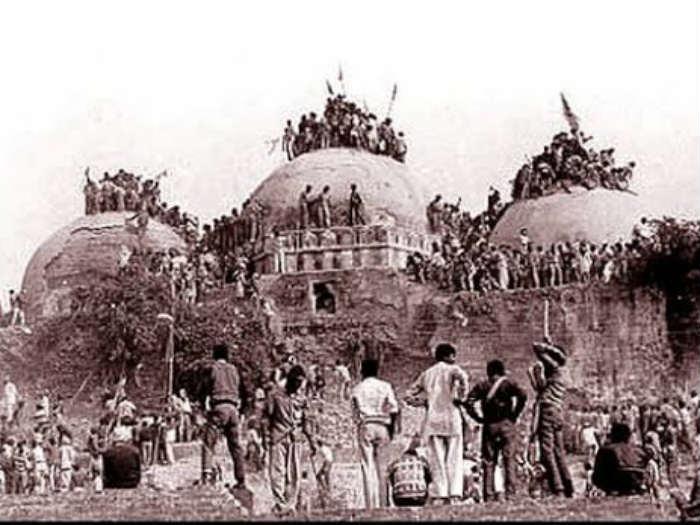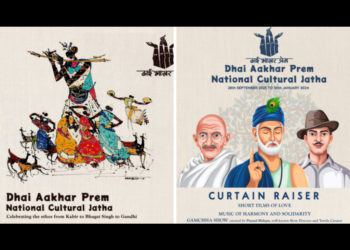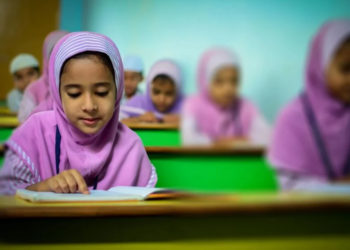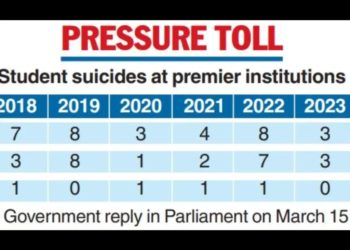December 6th, 1992, marked one of the darkest days of Indian history which witnessed the impact of the polarisation that had taken place within our society. On this day, prominent leaders of the BJP including L.K. Advani flagrantly flouted the orders of the Allahabad High Court and the Supreme Court, and brought down the Babri Masjid in a planned and organised manner. A Lucknow Bench of Allahabad High Court in 1989, had ordered a status quo over the disputed land. However, despite these orders a band of karsevaks surrounded the mosque and demolished it, thereby destroying the peace that was much required in the communally sensitive area of Faizabad and Ayodhya. It led to communal outrage, which further resulted in violence between the communities.
The land occupied by the Babri Masjid has been a subject for litigation since 1885, when Mahant Raghubar Das, the chief priest of the Ram Janmsthan filed a civil suit when the Faizabad Deputy Commissioner refused to let him build a temple on the land adjoining the mosque. However, despite the constant battle for power between the two communities, from 1951 to 1986, Faizabad and Ayodhya remained comparatively at peace and tension free. During this time, no legal activity was undertaken by either of the communities and the decisions pronounced by District and High Courts, i.e. the maintenance of status quo, prevailed. The Hindu and the Muslim communities co-existed, without any disruption. However, this changed after December 1992.
Following the demolition of the Babri Masjid, L K Advani and Murli Manohar Joshi, both senior leaders from the BJP, made communally inflammatory speeches which ultimately led to the demolition of the mosque and violence all over the country. Criminal conspiracy charges were brought against the leaders of the BJP but in May, 2010, the Allahabad High Court dismissed the petition for a direction to proceed with the conspiracy charge against L K Advani and others.
In September, 2010, the Allahabad High Court awarded two-thirds of the Ayodhya site to Hindu parties, and one-third to the Waqf Board. (see details of the litigation below) However, in May, 2011, the Allahabad High Court verdict was stayed by the Supreme Court, directing status quo to be maintained. The oldest litigant in this case passed away in December, 2014.
In March, 2017, a Supreme Court bench comprising of Justices P C Ghose and Rohinton Nariman posted for detailed hearing a CBI appeal against the dropping of charges for criminal conspiracy against L K Advani and Murli Manohar Joshi. While these proceedings are still pending, the Supreme Court is due to hear the Appeal against the judgment of the Allahabad HC on 5th Decemeber, just one day before the 25th anniversary of the demolition.
The Supreme Court has a mammoth task ahead, to decide one of the longest running disputes, which has historically been a volatile issue dividing the two communities.
Fuzail Ahmad Ayyubi, Advocate-on-Record representing respondent Haji Mehboob, provides a timeline for the Babri Masjid dispute as it played out:
The mosque was constructed in 1528, by the nobleman Mir Baqi, at the request of Babar, the first Mughal Emperor, hence the name Babri Masjid.
The following inscription can be found in Persian on the gate of the Mosque:
By the command of Emperor Babar, whose justice is an edifice reaching up to the very height of the heaven; the good-hearted Mir Baqi built this alighting-place of angles Buvad Khair Baqi (may this goodness last forever) the year of building made clear likewise, when I said Buwad khair Baqi (935 A.H) (i.e. 1528)
Though Ayodhya has been held to be the birth place of Hindu God Ram, based on the Ramayana written by Valmiki, there was no mention of any temple being destructed for the construction of mosque, not until 19th century, when British historians, based on popular local myths, started stating the story of the demolition of a temple known to be the birth place of the lord Ram by Mughal emperors and the subsequent construction of a mosque. Neither do the historical texts during the reign of Babar reflect any incident of such destruction. Thus since the mosque was built in 1528 till early nineteenth century, undisputedly, there existed a mosque used by Muslims for worshipping.
Legal History
The legal history of Babri Masjid begins from the construction of a “chabutra” or platform (17ft x 21ft area situated on the outer enclosure of disputed mosque) on 23.11.1857, inside the boundary wall of the Babri Masjid, which was known as the Janamsthan or the birth place of Lord Shri Ram. Thereafter, in 1857, the Nawab of Avadh declared different timings for the observance of namaz by Muslims in the mosque and worship on the chabutra, by the Hindus.
The first legal dispute arose in 1885, when Mahant Raghubar Das, the Chief Priest of Ramjanmsthan, filed a civil suit in the court of Sub-Judge, Faizabad on 15.01.1885 seeking permission to build a temple on the said chabutra. Pt. Hari Kishan Singh, the Sub Judge, rejected the plea on the ground of threat to public law and order situation. In his consideration if a temple were allowed to be constructed on the chabutra, being so close to Masjid, then it would ‘lay the foundation of death and murder.’
The Mahant then appealed to the District Court of Faizabad. Colonel J E A Chamber, after an inspection of disputed land, dismissed the appeal and held that a temple could not be built without inflaming communal passions. Subsequently, a railing was built to separate the chabutra from the Masjid imposing a physical boundary between both communities. In his Judgment, he observed:
I found that the Masjid built by Emperor Babar, stands on the border of the town of Ayodhya. It is most unfortunate that a mosque should have been built on the land specially held sacred by the Hindus. But, as that occurred 356 years ago, it is too late now to remedy the grievance. All that can be done is to maintain the parties in status quo.
Raghubar Das, on 25.05.1886 filed his suit again which was dismissed by the Judicial Commissioner of Oudh, who in his judgment, observed that the plaintiff’s earlier suits have been dismissed, on the ground that the plaintiff had no evidence to support his claim that the place belonged to Hindus, but, while dismissing the suit he observed that:
This spot is situated within the precinct of the grounds, surrounding the mosque erected some 350 years ago, owing to the bigotry and tyranny of the Emperor, who purposely chose this holy spot which according to Hindu legend was the site of the temple. The Hindus seemed to have very limited right of access to certain spots, within the precincts adjoining the mosque and they have, from a series of years, been persistently trying to increase those rights and to erect buildings on two spots, namely Sita-Ki-Rasoi and Ramchandra –Ki- Janmabhumi.
Afterwards, in March 1934, communal riots arose when allegedly a cow was slaughtered by Muslims in the adjoining region of Ayodhya. The Hindus tried to ravage the mosque and damaged it, but it was repaired by the funds collected through the fine imposed on Hindu rioters.
In 1936, in response to an enquiry, the Commissioner of Waqf Boards expressed, that mosque was built in 1528, by Babar, the emperor and a Sunni Muslim.
Another litigation concerning this mosque came up in 1945, involving, Shia and Sunni. Both sects claimed the mosque. The local Civil Judge, S A Ahsan, declared in his pronouncement on 23.03.1946, that although mosque was built by Babar who was a Sunni, yet there is evidence that it was used by both the sects.
Post partition, in December 1949, the controversy rose again and the legal battle started. Some Hindus allegedly kept the statues of Rama, Sita and Laxman during the night of 22-23 December 1949 inside the mosque, thereby attracting Hindu believers to gather for sacred viewing, Darshan, of the deity.
This incidence led to communal confrontation. Pt. Jawahar Lal Nehru, ordered Govind Ballabh Pant, the then Chief Minister of Uttar Pradesh to remove the statues. However, K K Nayar, the District Magistrate, refused to remove the idols because he asserted that removing the idols will flare up the communal riots.
The court decided to maintain the status quo till the finalisation of decision of ownership. The gates of disputed place were locked. The Additional Magistrate of Faizabad and Ayodhya, Markendey Singh, appointed the Chairman of Municipal Board of Faizabad-Cum-Ayodhya, Priya Dutt Ram, as receiver, to arrange for case of property on dispute.
Later on, Gopal Singh Vishared, a Sanatan Hindu and an inhabitant of the Ayodhya city, filed a suit on 16.01.1950 in the Civil Court urging entitlement of worship, and unobstructed visit to idols and sought a perpetual injunction, restraining the defendants from removing the idols. The Civil Judge, V N Chadha on 19.02.1950 granted a temporary injunction which was later on confirmed in his judgment on 03.03.1951, where the Judge recorded it as an undisputed fact that on the date of the suit, the idols of Lord Ram and others, did exist on the site and that worship was being performed by Hindus, including the plaintiff though under some restrictions put by the executive authorities.
On behalf of UP Govt., Dy. Commissioner, Faizabad, J.N Ugra filed a written statement on 24.04.1950, stating that, “The property in suit is known as Babri Masjid and it has been for long time in use, as a mosque for the purpose of worship of the Muslims. It has not been in use as a temple of Shri Ram Chandraji.” The next para of the statement pronounced by Deputy Commissioner added that, “On the night of 22 December 1949, the idols of Shri Ram Chandra Ji were surreptitiously and wrongly put inside.” In the paragraph 16 it added that, “That as a result of the said wrongful act, a situation imperiling public peace and tranquility was created and public authorities had to intervene in order to prevent the breach of peace and tranquility.”
Along with the suit number 2 of 1950, filed by Gopal Singh Vishared, three more suits were filed by other parties, regarding receivership and waqfs of site.
In 1959, Nirmohi Akhara also filed a suit for ownership of the disputed land. All those suits continued to be justified.
On April 26, 1955, Allahabad High Court, confirmed the status quo order, issued by the Civil Judge V N Chadha in 1950.
The Sunni Waqf Board filed their suit No. 12 on 18.12.1961 in the court of Civil Judge Faizabad seeking help from court in declaring a portion of area as a public mosque, commonly known as “Babri Masjid” and area beyond referred mosque, was a graveyard of Muslim public.
From 1951 to 1986, Faizabad and Ayodhya remained comparatively at peace and tension free. During this time, no legal activity was undertaken by either of the communities. During the aforesaid time of 36 years, the decisions pronounced by District and High Courts, i.e. the maintenance of status quo, prevailed. The Hindus continued the Akhand Kirtan in front of mosque to ‘liberate’ the ‘Shri Ramjanmabhumi’ since 23.12.1949, without any disruption.
On 25.01.1986, an advocate Umesh Chandra Pandey, submitted a new application within the case no. 2/1950 filed by Gopal Singh Vishared demanding the locks to be opened and the Hindus to be allowed to worship the idols. It was a matter of astonishment that all claimants or defenders of case no. 2/1950, had died and case also, was barred according to law. So, no new claimant could be entered without permission of the court. But it had happened and without permission of the court, the application of Umesh Chandra Pandey, was accepted under the old case and the judiciary refused this demand on 28 January. 1989.
An appeal was then filed against the referred order, before District Judge, K.M Pandey on 31.01.1986. Within a day of this appeal, 1.02.1986 was fixed for the final hearing. The District Judge ordered on the same day directing the state of Uttar Pradesh, the District Magistrate and Superintendent of Police, Faizabad to open the locks, finding them to be “an unnecessary irritant to the applicant and other members of Community”, and not to impose any restriction or cause hurdle in the darshans of applicant and other members of the Hindu community.
Gates of Babri Masjid were unlocked in the presence of police security after the pronouncement of this judgment. On 3rd February 1986, Mohammad Hashim filed a case in High Court, seeking stay on the aforesaid order of District Judge Faizabad. The court gave an order on the same day to the maintenance of status quo “as existing today” till the further order. The Sunni Waqf Board also put a petition on 12 May 1986, against the order of the District Judge, to open locks.
The Lucknow Bench of Allahabad High Court clubbed together all cases pending over Mandir-Masjid dispute on 14.08.1989, and issued an interim direction to maintain status quo regarding the disputed property.
The leaders of VHP promised the Home Minister, Buta Singh, that they will act upon the aforesaid directions of Lucknow Bench of Allahabad High Court, given on 14.08.1989, to the effect that, “Parties to the suit shall not change the nature of property in question and ensure that the peace and communal harmony are maintained.”
The foundation stone of Mandir was laid on 9.11.1989, quite near the Babri Masjid and Kar Seva began, which was stopped the next day by the order of District Magistrate. The VHP claimed that Shilanyas was laid on the undisputed land. But it was done at plot no. 586, claimed by Sunni Waqf Board as having been used for long as a Muslim burial ground.
Therefore, all legal suits related with Ayodhya were allotted by Supreme Court to Lucknow Bench of Allahbad High Court in 1989, which ordered a status quo over the disputed land. But, despite this legal situation, Babri Masjid was demolished on 6 December, 1992.
After this, the then Prime Minister, Narsimha Rao, by the permission of the Parliament, vide Ayodhya Ordinance 1993 which eventually became the Acquisition of Certain Areas of Ayodhya Act, took whole of 67 acres in its possession on 07.01.1993, on the same day, the President of India vide the Parliament Act 143 (1) allotted the whole case to Supreme Court but Supreme Court again sent the case to Allahabad High Court. As according to the Indian Constitution, Supreme Court cannot put aside the decision pronounced by High Court, while providing its own decision with referred legal action on 24 October 1994, the Supreme Court restricted any construction of any kind on 67 acres of land. Moreover, it announced to maintain status quo till the further orders.
The case remained pending further for 6 years and in 2002 Aslam Bhoora, proceeded to the court. The court held on to its previous decision of 24.10.1994 and on 13.03.2002 ordered to maintain status quo. In March 2003, Lucknow Bench of Allahabad High Court ordered Archaeological Survey of India to dig land around the Babri Masjid site however the resulting report was not of help.
Besides the above mentioned civil suits, several other disputes relating to speeches and the incident of 06.12.1992 are under process in various commissions and judicial agencies.
Lucknow Bench of Allahabad High Court, on 30.09.2010, delivered a decision and declared that disputed land will be divided in three parts with the portion below the central dome where the idols are kept going to the Hindus; Nirmohi Akhara would be allotted land including Ram chabutra and Sita ki Rasoi and one the third land would be allotted to Suni Waqf Board and if minor adjustments are required, the land acquired by central government could be allotted. After this, the judgment was criticized by different scholars, historians, political commentators and lawyers because it was based on ‘faith’ and not on ‘facts’.
After this, against this judgment, many parties which appealed in Supreme Court, included the Suni Waqf Board, Nirmohi Akhara, All India Hindu Maha Sabha and Bhagwan Shri Ram Virajman. On May 2011, Supreme Court stayed the verdict on Ayodhya of Allahabad High Court. Justice R.M. Lodha declared the High Court verdict to be “strange”. He observed, “The decree of partition was not sought by the parties. How can a decree for partition be passed when none of parties had prayed for it?” The Bench said that the status quo at the disputed site would remain as directed by the 1994 constituted Bench and order passed on March 13-14, 2002. The Bench while directing the status quo to continue, made it clear that the existing puja in the make-shift Ram Lala temple at the disputed site, would go on as usual.
The matter is to be heard by the Hon’ble Supreme Court of India in December 2017.
On Friday (December 1st) Citizens for Justice and Peace has filed an intervention application in this case. They have requested in their petition that having regard to the fact the that it is not just a matter that concerns the Plaintiffs and the Defendants alone, but relations between almost every citizen in India who seek justice and peace, the matter should be referred to a Constitution bench of seven judges.
Excerpts from the petition are given below:
“52. It is further stated by the Applicants that, though the exact series of events that had occurred while the present dispute was being heard by the High Court might not occur again, it cannot be denied that the said dispute is not just a dispute between the Plaintiffs and the Defendants. The Plaintiffs and the Defendants represent a larger demographic of entire communities for whom the said dispute has become contentious and sensitive. It cannot be denied that, with the unrest in the atmosphere as is present today, there is still an evident possibility that adjudication upon the present dispute is likely to cause unrest and disturbances of violence in the country. There is also a possibility that there still exist elements who are likely to exploit the controversy of the present dispute for their own advantage at the cost of lives of innocent. Thus, it makes it even more significant, that this Hon’ble Court may take into consideration that, the issue in the present appeals is not just a dispute over property between the Plaintiffs and the Defendants but has several other issues which will have far reaching effects on the secular fabric of the country.
- The Applicants submit that unfortunately secularism is being manipulated by all groups political or otherwise. Muslims claim special privileges in the name of secularism, Hindus demand a reversion to a time that exists only in the political imagination. This issues before the High Court involved a civil suit and, in our humble view, could not have decided the larger issues of constitutionality. In view of the fact that neither party was able to establish their case, no one should have succeeded, even partially. It appears that finding no way to balance these two, the High Court decision attempts a secular solution that unfortunately does not put the festering wounds caused by this conflict to rest.
- It is therefore most respectfully prayed that this Hon’ble Court upholds the high ideals of secularism and the rule of law. Today it is a battle of unequals within the courts as a divisive and cataclysmic movement and event is given legitimacy by the powers that be, and all of India, young and voiceless millions want to see the end to this deliberately perpetrated conflict. The only situation lies today In each of us Indians rising above narrow confines of class, caste, community and gender and dedicate the spot that has come to signify conflict to a constructive non religious purpose.
- For over three decades, this peace loving people of India, practicing co existence and negotiation between different faiths and languages, who have been held hostage to this dispute, have been, unfortunately, not heard. Their vast voice has simply not been heard. This small group of representatives Indians represents that vast, silent voice, that wishes above all peace harmony and collective advancement of all Indians.
- That the applicants also submit that by virtue of the nature of the dispute this Hon'ble Court may also consider the necessity to constitute a larger bench of at least 7 judges as certain Constitutional questions are bound to arise and there may be a need to re-consider the judgement of this Hon’ble Court in Ismail Faruqui v. Union of India (1994) 6 SCC 360.”
Read the full text of the petition here.
Read the statement by CJP:
Citizens for Justice and Peace, a human rights and legal resources platform dedicated to fighting communalism and discrimination, and for the rights of one and all, is now intervening in the Ram Janm Bhoomi – Babri Masjid case along with a galaxy of prominent Indians from various walks of life, from across the length and breadth of the country. CJP’s plea is that the Supreme Court exercise its jurisdiction, not treat this matter like a narrow property dispute and instead recognise the ramifications of letting religion dictate the fate of a piece of land.
CJP implores the court to take cognisance of the meaning of the word Ayodhya, a compound word formed by adding together ‘a’ meaning ‘without’ and ‘yudh’ meaning ‘war’. Ayodhya, a space that should exist for all, without conflict, has come to symbolise a vicious and bigoted conflict between communities.
This voice of peace-loving and concientitious citizens, held hostage to the conflict, has appealed to the Supreme Court not to treat the dispute as just a property dispute between the litigants but one that has a bearing on the fundamentals that this country stands on, its Constitution.
Interveners include close to three dozen Indians from across the country and from various walks of life, from Shyam Benegal, Aparna Sen, Om Thanvi, RB Sreekumar, Anand Patwardhan (Ram Ke Naam), Ganesh Devy, Medha Patkar, Aruna Roy, Anil Dharker, Ganesh Devy, Teesta Setalvad, Joy Sengupta, Cyrus Guzder, Ram Rahman, Sohail Hashmi, MK Raina, to Dr. BT Lalitha Naik and John Dayal. Others include: Suman Mukhopadhyay, Kiran Nagarkar, Kumar Ketkar, Kalpana Kannabiran, KL Ashok, KP Sripala, AK Subbaiah, Suresh Bhatt Bakrabail, Prof G Haragopal, N. Babaiah, Tanaz Dara Mody, Muniza Khan, Tanveer Jafri and Dolphy D'souza.
“The outcome of this dispute, perpetrated and violent, has the potential to affect the very foundations on which Indian democracy stands,” says Teesta Setalvad, Co-founder and Secretary, CJP. “It is time for the wounds caused by this conflict to heal and for peace-loving citizens of all communities, young and old to speak up for an inclusive and forward looking solution. This matter concerns the very soul of India,” she adds.CJP filed its intervention application to the civil suit on Dec 1 and is likely to present its stand when hearing begins on Dec 5 at the Supreme Court. Meanwhile, it has uploaded an online petition on its website, seeking ordinary Indians sign up in support of Peace in Ayodhya.





